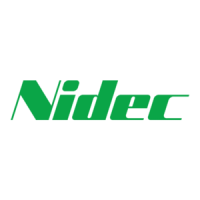What to do if Nidec NE300-4T0075G/0110PB show output phase loss?
- JJulie OconnellSep 8, 2025
If your Nidec DC Drives are showing an output phase loss, check the U-V-W motor wiring. Also, if there is a serious unbalance in output, check the load.

What to do if Nidec NE300-4T0075G/0110PB show output phase loss?
If your Nidec DC Drives are showing an output phase loss, check the U-V-W motor wiring. Also, if there is a serious unbalance in output, check the load.
What to do if Nidec NE300-4T0075G/0110PB DC Drives show load short-circuit?
If your Nidec DC Drives are displaying a load short-circuit error, check whether the electric motor coil is short circuit. If the inverting module IGBT is damaged, ask for the services from manufacturers.
What to do if my Nidec DC Drives show motor overload?
If your Nidec DC Drives indicate a motor overload, several factors could be responsible. First, check the input power source for any abnormalities. Ensure the motor's rated current is correctly configured in the settings. If the V/F curve isn't suitable, adjust it along with the torque boosting performance. For motors consistently operating with heavy loads at low speeds, consider using a specialized electric motor. Also, verify that neither the motor nor the load is blocked or experiencing sudden, large load changes. Finally, if the motor power is insufficient, use a motor and drive with appropriate power ratings.
What causes bus under voltage during running of Nidec DC Drives?
A bus under voltage during the operation of Nidec DC Drives is caused by power grid low voltage, so check the input power source.
What to do if Nidec DC Drives show fast current limit fault?
If your Nidec DC Drives are showing a fast current limit fault, it could be due to a load that is too large or a motor blocked to stall, so decrease the load and check the motor and mechanical part status. If the drive power rating is too small, choose a higher power drive. If the drive output circuit loop is grounded or short-circuited, remove the external fault.
What to do if my Nidec DC Drives show over Voltage in Acceleration?
If your Nidec DC Drives display an overvoltage during acceleration, it could be due to a too short acceleration time, so increase it. Another possible cause is an abnormal power supply, so check the input power source.
What to do if my Nidec DC Drives show over voltage in constant speed?
If your Nidec DC Drives are showing an overvoltage at constant speed, first check the input power source for abnormalities. If the load inertia is large, add suitable braking devices.
How to fix heat-sink over heat in Nidec DC Drives?
To resolve heat-sink overheating in Nidec DC Drives, first lower the ambient temperature. If the fan is damaged, replace it. Also, ensure the fan air duct is clear of any blockages.
What to do if my Nidec NE300-4T0075G/0110PB DC Drives show over voltage in deceleration?
If your Nidec DC Drives are showing an overvoltage during deceleration, the deceleration time may be too short, so increase it. Also, if the load inertia is large, add suitable brake devices.
What causes over current in Nidec NE300-4T0075G/0110PB DC Drives during deceleration?
Overcurrent during deceleration in Nidec DC Drives can occur due to several reasons. If the deceleration time is too short, increase it. If there is a large load inertia, add suitable brake devices. Finally, if the drive power rating is too small, choose a higher capacity drive.
Important safety warnings related to the use of the drive, including operational restrictions.
Safety precautions for installing the drive and handling the product, including mounting.
Safety guidelines for electrical wiring, including grounding, terminal connections, and cable management.
Safety measures for operating the drive, covering power supply, commands, and parameter changes.
Safety precautions for maintenance and inspection, including electrical shock and static discharge.
Comprehensive list of technical specifications for NE200 and NE300 drives, covering control features and environment.
Lists environmental conditions to avoid when installing the product for optimal performance.
Illustrates the connection diagram of the drive with peripheral devices like power supply and motor.
Details important precautions for power supply and motor wiring to prevent damage.
Details the three-level menu structure for viewing and modifying function codes and parameters.
Details parameters related to starting and stopping the drive, including start modes and DC braking.
Details parameters for vector control, including speed loop, current loop, and torque control.
Lists parameters for motor identification, including type, power, current, and resistance/inductance.
Details PID control parameters, including setup channels, proportional gain, and integration time.
Details parameters for multi-step speed control and PLC programming, including frequency settings and step durations.
Lists parameters for motor overload protection, electro-thermal protection, and current limits.
Provides a table of common trip codes, their types, possible causes, and solutions for troubleshooting.
Offers a guide for simple analysis and countermeasures for common abnormal situations.











